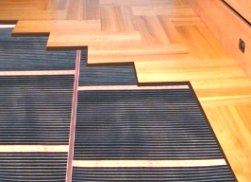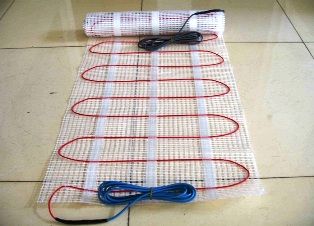Categories: Featured Articles » Controversial issues
Number of views: 117817
Comments on the article: 14
Which electric floor heating to choose: cable or infrared?
 Until recently, on sale you could find two types electric underfloor heating: based on heating cables and heating mats. They did not have differences in the principle of operation, and the choice between them depended only on the features of the room in which floor heating is required.
Until recently, on sale you could find two types electric underfloor heating: based on heating cables and heating mats. They did not have differences in the principle of operation, and the choice between them depended only on the features of the room in which floor heating is required.
A few years ago, a fundamentally new floor heating appeared on the market based on infrared films. Manufacturers unanimously declare the numerous advantages of this type of electric underfloor heating. Many people who carry out repairs in their apartments are interested in the question: “What kind of electric floor heating to lay?”.
The main argument of sellers in favor heating films - beneficial effects of infrared radiation on the human body. Indeed, medical research has established the healing properties of infrared radiation. It is used in physiotherapy to treat many diseases. But according to physics textbooks, many bodies are opaque to this kind of radiation; laminate, ceramics, and linoleum can also be attributed to such bodies.
No film manufacturer guarantees that your floor will transmit radiation that is beneficial to the body. Therefore, it can be argued that sellers' statements about the healing properties of infrared-based floors are to some extent a marketing ploy.
One of the main advantages of infrared films is lower energy consumption compared to heating cables, by about 15-20%. This phenomenon is explained by the absence of a screed on top of the film, as a consequence of heat losses in it, too.
However, do not forget that the screed is a protective layer that protects the electric underfloor heating itself from damage, and you and me - from electric shock. And in the case of infrared films, you actually walk on conductors with current, on top of which there is a floor covering. You can certainly use films with a supply voltage of 12 V, but in this case an unreliable element appears - a power supply.
As another advantage of infrared films, manufacturers indicate the ease of replacing part of the film in the event of a malfunction. This is achieved by connecting the heating elements in parallel. However, these same connections are precisely the most unreliable part of the system. At the same time, the heating cable is a solid conductor, the only weak point is the coupling, the location of which is recorded in the passport, and in case of failure it can also be replaced.


Underfloor heating
In general, you can recommend the use of infrared films in case you did not plan to carry out serious repairs. For example, you can lift an already lying floor covering and lay the film under the bottom. Also, infrared floor heating is indispensable in case there is no way to raise the floor level due to screed.
Heating cables are best used in the bathroom, on the balcony, in the children's room. Since they have better waterproofing, and are able to provide greater electrical safety. In addition, ceramics or tiles are easier to lay on a screed than on infrared film.
Summing up, we can say that the electric underfloor heating based on infrared films is quite promising, capable of displacing other types of underfloor heating in the near future. However, today, due to some of its shortcomings, most consumers prefer heating cables.
See also at bgv.electricianexp.com
:
